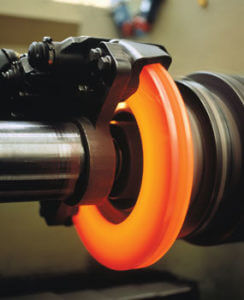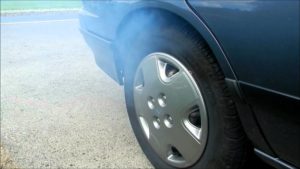Brakes smoke after replacing pads
Why do brakes smoke after replacing pads?
It’s not uncommon to see brakes smoke after replacing pads. Brake pad manufacturers refer to this as the polymerization or curing process. The heat caused by normal braking on new brake friction materials causes the pads to go through this final curing process.
Many DIYers and customers think their new brakes are burning up.  Not true. The smell and smoke aren’t caused by oxidation. What you smell is gasses formed
Not true. The smell and smoke aren’t caused by oxidation. What you smell is gasses formed  during the curing process. It’s a completely normal process, not something you should worry about. The smoke and smell should get significantly better by the second day of driving after pad replacement.
during the curing process. It’s a completely normal process, not something you should worry about. The smoke and smell should get significantly better by the second day of driving after pad replacement.
Why some brake pads need a curing process?
If new brake pads are heated too quickly or beyond a certain heat level, the friction material can lose some strength and the off-gassing can cause brake fade. So stomping on your brakes right after a brake job should be avoided unless specifically recommended by the brake pad manufacturer. Some brake pad manufacturers do recommend braking from high speeds, but those pads are usually designed for racing. Street brake friction materials should never be broken in or cured using this process.
Did you follow the “burnishing,” “bedding” brake pad break-in procedure?
Most brake pad manufacturers specify a break-in procedure known in the industry as “bedding or burnishing,” although a few manufacturers don’t recommend any special procedure. The bedding process does several things:
• it cures the friction material,
• it embeds friction material into the pores of the brake rotor to form a transfer layer film coating of friction material,
• it smooths the rotor surface.
Since brake pads differ in their formulation and manufacturing methods, manufacturers may recommend different break-in procedures for each type of brake pad. There is no single bedding procedure for all pads. For example, a manufacturer may use a molding technique that uses less binding resin but bakes them at a higher heat that cures them more fully in the mold. A different manufacturer’s brake pad formula may use a higher-priced or special resin that creates a distinct smell during the curing process.
Common brake pad burnishing procedure
• 10 to 20 gradual stops from 30 mph
• 10 to 20 gradual stops from 30 mph with 30-second rest time between cycles
• moderate driving with no heavy braking for the first 500 miles
Most brake pad compounds will take up to 300-400 miles to fully develop an even transfer film on the rotors.”
AKEBONO procedure
400 to 500 miles of moderate driving is recommended. Avoid heavy braking.
ATE procedure
400 to 500 miles of moderate driving is recommended. Avoid heavy braking
BREMBO GRAN TURISMO procedure
Apply brakes with moderate pressure slowing from 60 mph to 30 mph. Drive one-half mile to allow the brakes to cool, then repeat the procedure 30 more times.
HAWK procedure
Apply moderate braking pressure 6 to 10 times from 35 mph. Then make 2 to 3 more hard stops from 40 to 45-MPH without allowing the vehicle to come to a complete stop. Park the vehicle and let the brakes cool completely.
Raybestos Procedure:
If you’re using the brakes for severe duty like police or taxi service, or before track testing, perform a more rigorous burnishing process:
• 8 moderate brake applications from 40 to 10 mph at approximately ¼-mile intervals.
• 8 somewhat harder brake applications from 60 to 10 mph at approximately ½-mile intervals.
• Drive 1.5 miles
• Allow brakes to cool at least 15 minutes either by parking the vehicle or continuing to drive at moderate speeds with minimal brake applications.
©, 2017 Rick Muscoplat
